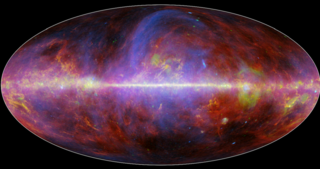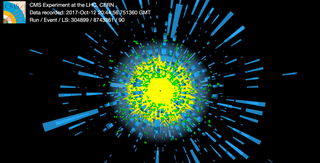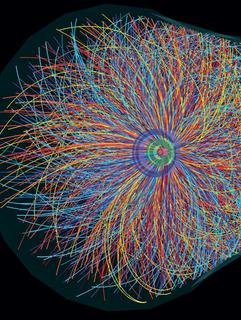Going back to the very first moments of the universe at the LHC at CERN
In one of my last post on the LHC, I mentioned that the LHC machine is now, at the actual time of writing this post, accelerating xenon atoms that are then violently smashed against each other. On top of colliding protons, the LHC is indeed also colliding another type of particles named heavy ions.
In a couple of words, this consists in accelerating and colliding heavy atomic nuclei. And this of course comes with a fully dedicated research program.

[image credits: BNL]
The idea behind the collisions of such heavy particles is to recreate, in LHC collisions, an environment similar to what could have happened during the very first moments of the universe.
However, energetic protons are not sufficient for that. We indeed need to accelerate much more massive objects.
Heavy ions, or atoms whose electrons have been stripped away, are perfect beasts with this respect. More mass means a denser environment when the two particles collide, which is what we need to recreate the first moments of the life of the universe, as I detail below.
A COSMIC SOUP - THE FIRST MOMENTS OF THE UNIVERSE

[image credits: PLANCK]
The standard model of cosmology is based on the Big Bang hypothesis. This story begins 13 billions years ago. During the first 0.000….01 second (with more than 30 zeros) of its life, the Universe was exponentially expanding.
This is the so-called the inflation epoch. After this tiny fraction of a second, inflation reduces its pace to a rhythm somehow calmer, without stopping.
Right after inflation, the early Universe looks like a cosmic soup of matter and energy. In this soup, particles are moving at the speed of light and interact with each other constantly. More precisely, particle-antiparticle pairs are both created from the vacuum, and they annihilate into energy.
We have thus a thermal equilibrium: a same amount of particle-antiparticle pairs are created and annihilated.
A few microseconds later, things however change. The temperature continues to go down, protons and neutrons are formed and matter starts to rule the universe.
FROM THE EARLY UNIVERSE TO THE LHC
Physicists are trying to reproduce these very first moments of the universe in experiments. They are actually trying to prepare this soup of matter and energy that I was mentioning in the previous section.
We need two ingredients here, a hot temperature and a large density of matter. And powerful detectors to obviously observe what is going on.

[image credits: CERN]
And this is where our heavy ions come into the game.
In lead-lead collisions for instance (it works as well for gold-gold collisions, and hopefully for xenon-xenon collisions too), several hundreds of protons and neutrons are involved.
Equivalently, this means plenty of matter (and thus a very dense environment) and plenty of energy (and thus a high temperature).
Our heavy nuclei are indeed accelerated at very high speed (close to the speed of light), so that the experimental conditions are really suitable to yield the formation of the so-called plasma of quarks and gluons (the technical word for the cosmic soup that I discuss about from the beginning of this post).
A small reminder is in order. Quarks and gluons are the most basic constituents of matter, and in particular of the neutrons and protons. Heavy ion collisions leads to the production of a tiny fireball where all matter is melted to its more fundamental form, those actual quarks and gluons.
This fireball is extremely dense, as the initial matter turns to be melted and concentrated in a very small amount of space. In other words, we get the very exact same conditions as in the early universe! And we are thus ready to observe our cosmic soup! :)
FROM THE PLASMA TO THE DETECTORS
The quark-gluon plasma does not last for long. It cools down very quickly so that we almost immediately get back to ordinary matter that is spread in all possible directions. An example of the corresponding record in an LHC detector can be observed in the image below on the right.

[image credits: CERN Courier]
We have hits in the detectors everywhere. This is not surprizing knowing the amount of matter we had to start with.
However, we have (thousands of) records of the collision events, so that physicists can study them to get more information on the quark-gluon plasma and thus on the very first moments of the universe.
For instance, we can consider jet quenching. A jet is a collimated beam of strongly-interacting particles. When a very energetic strongly-interacting particle is produced, it radiates other strongly energetic particles, that eventually form plenty of composite states propagating in the initial direction. This is what is called a QCD jet.
Jets produced in proton-proton collisions are well known from usual LHC studies. However, when they are produced within a quark-gluon plasma, jets are interacting with the medium, so that their properties are importantly modified. They in particular loose energy when propagating throughout the plasma.
Studying these modifications allows to go back to the properties of the plasma and how it behaves. And to come back to the topic, we in fact learn on the form of matter that was the one at the very first moments of the universe.
We have at the moment models (for instance, hydronamics models to quote a name) detailing the behavior of the plasma, and it is crucial to understand and constrain them better, possibly from basic principles.
SUMMARY AND REFERENCES
In this post, I discussed a state of matter called the quark-gluon plasma. This is a state of matter that looks like a soup made of quarks and gluons, the most inner (and thus elementary) components of matter (neutrons and protons are made of quarks and gluons).
Why is this important? The reason is very simple: in the standard model of cosmology, this is how the universe was looking like at the very first fraction of second of its existence. Moreover, the theoretical understanding of what is going on here is in addition one of the greatest challenge for quantum chromodynamics.
Thanks to the Large Hadron Collider at CERN (and actually other colliders too), physicists can reproduce the conditions of the early universe and study the quark-gluon plasma and its properties.
More information on this cosmic soup of matter and energy can be found here and there, for instance. This article and the references therein is also great to learn more! For fresh LHC physics results on the properties of the plasma, see here.
For more discussion on this topic (or anything related to science), please join us on steemSTEM. SteemSTEM is a community driven project which seeks to promote well written/informative Science Technology Engineering and Mathematics postings on Steemit. More information can be found on the @steemstem blog.
Going back to the very first moments of the universe... my grandmother was there telling someone her problems.
We were somehow all there... in parts :p
I am among those who believe that science has great beauty.
This is informative, well researched and compiled. Watching some videos on youtube about this, I'm willing to learn more.
Thanks for sharing @lemouth.
My pleasure! I hope that you will find nice videos ^^
I don't know why I've always had inner reservations about the big bang. There's a question I've had in mind, it could sound foolish though, but permit me to ask it: Did the big bang actually happened?
It is a theory. We don't know, but all the predictions of this theory agree with data. So for the moment, this paradigm is the most considered.
Quark-gluon plasma
Wow, science remains an inconclusive quest and attempt! From one diversity to another.
Good post @lemouth.
Thank you. To me, understanding it is really one of the current challenges of particle physics (among many actually :p)
Did you guys know that they got a statue from India?
A dancing Shiva statue which can represent him as Shiva the Destroyer :D
Destruction is part of creation. You can see it even in the seasons: look how destructive autumn is. ;)
Exactly :)
Yes I know. :)
Do you know why there is a statue of Shiva there (on top of the India gift reason)? I will give the answer that can be also found everywhere on the web today:
See **here**, for instance, for more information.
Nice post... i like this
Thank you!
Nice
I find it nice too! :)
Very informative post, one cant help to think this is a sinister machine as is cern.
Why is the LHC sinister? What is wrong in trying to understand how the universe work?
PS: CERN is not a machine but a research laboratory.
Good content and best information @lemouth.. Thanks for sharing
My pleasure!
@lemouth... All your posts are very useful for newly installed steemit users like me .. thanks a lot. always healthy.
Regards from Indonesia.. 😉
I am really happy that you like my posts :) It is always nice to hear that from a reader :)
Keep writing @lemouth.. Keep inspiring :-)
I follow some of the ideas by the guys at Quantum research gravity, when I can find time for it. If reality is pixelated what geometric code lies behind it?
Observations from CERN showed that all fundamental particles and forces transform into one another through the process of gauge symmetry transformation. These conversions correspond to the geometric E8 lattice. Also known as the Gosset polytope, when projected to a 4 D structure, it gives rise to two similar objects of different sizes. The ratio of the 2 structures is the Golden ratio. What do you think about the nature of this reality being a projection of a higher dimension? BTW I am sure I made mistakes in understanding a bunch of this stuff. You must forgive my ignorance.
I don't know anything about that. Therefore, I am afraid I can't comment. It however looks very pseudoscientific to me after a quick look on their website. This goes along the same lines as what I have found here. In short, don't loose to much time in this :)
Not only at CERN but from all particle physics experiments from the last 50 years.
Thanks boss. It is attention catching but did look like hocus pocus.
My pleasure :)